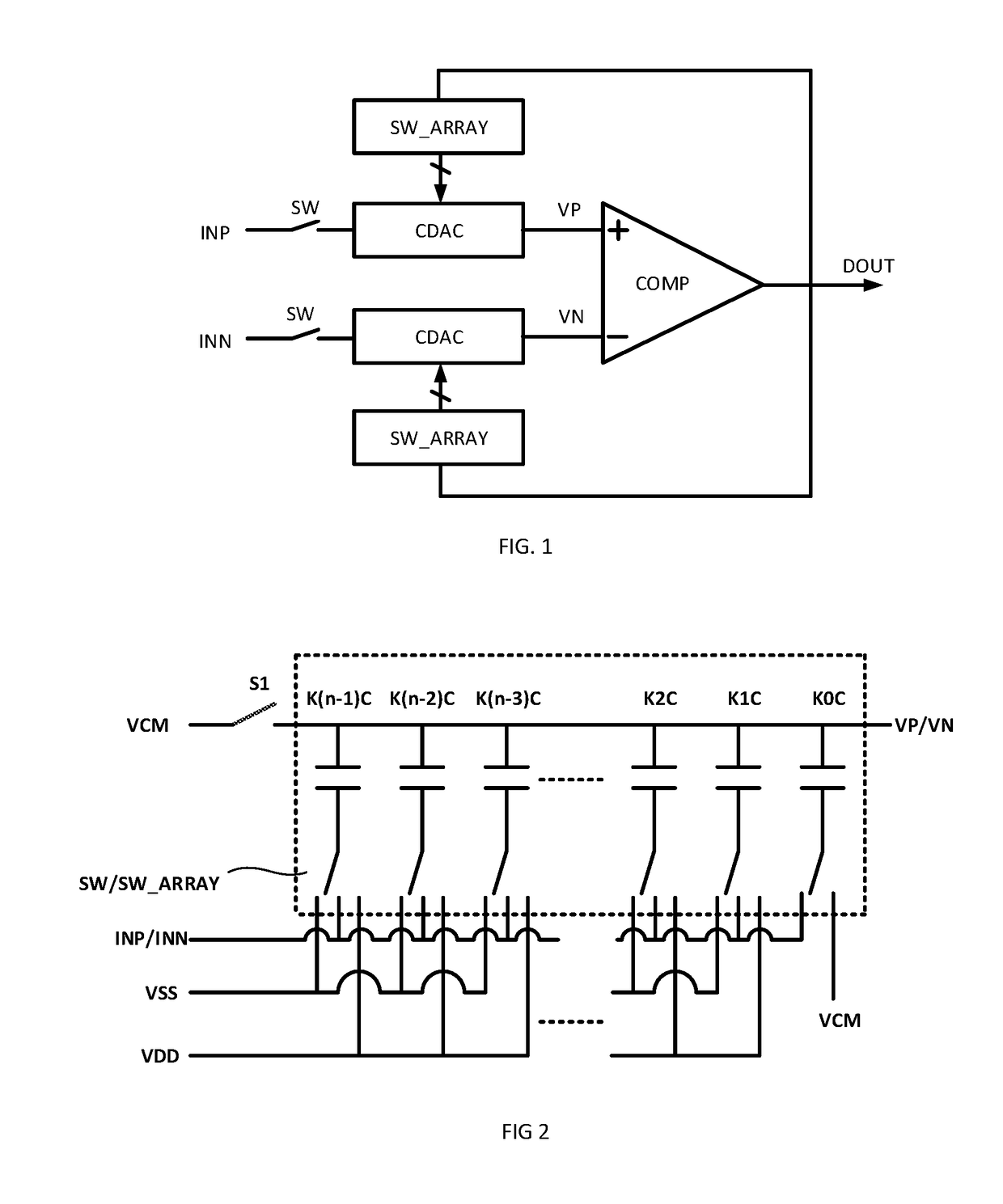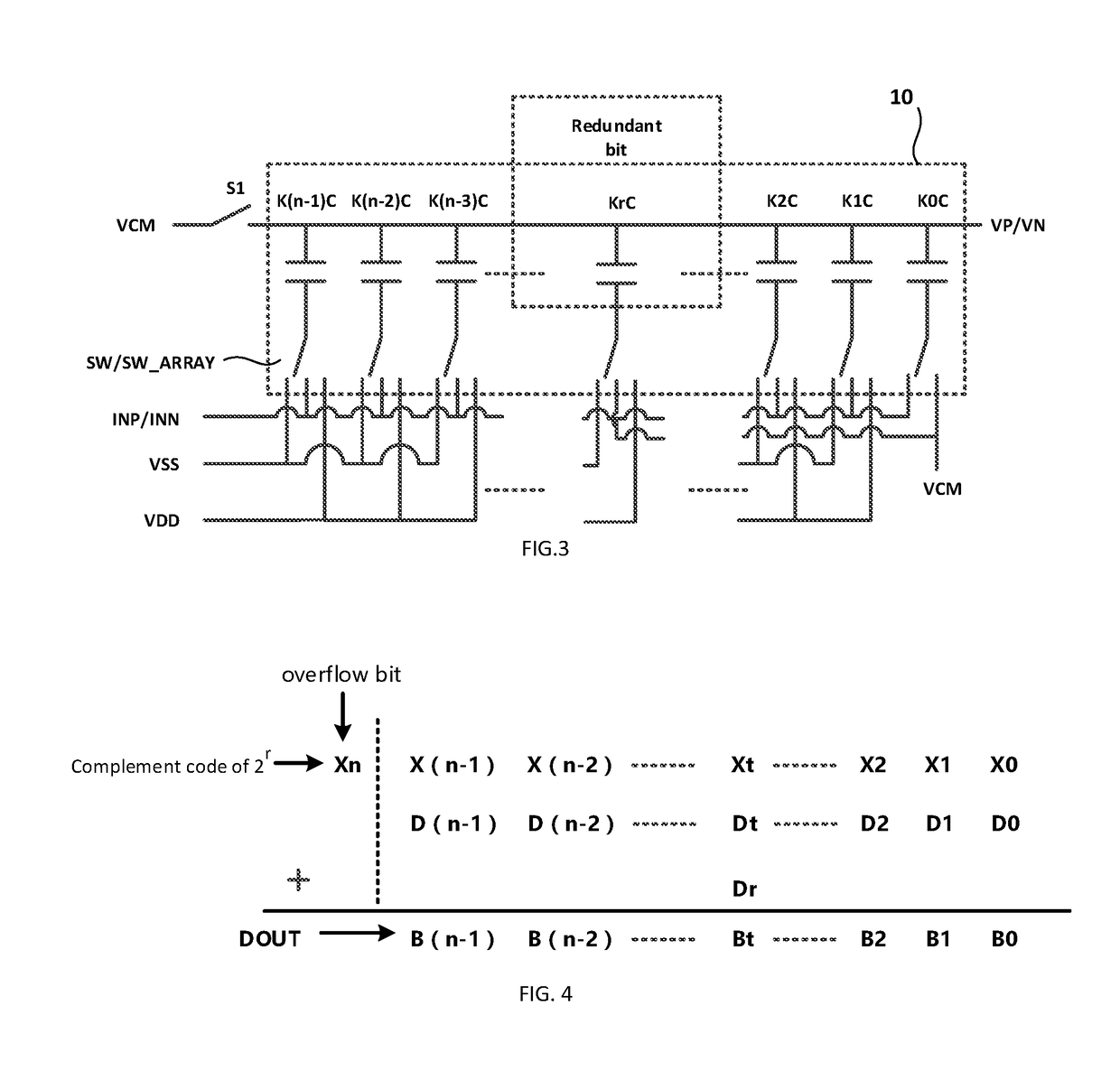Analogue-digital converter of non-binary capacitor array with redundant bit and its chip
a capacitor array and capacitor array technology, applied in the field of analog-digital mixed integrated circuits and analog circuits, can solve the problems of inability to achieve the trade-off between speed and size, inability to meet the requirement of high-speed low-power successive approximation analog-to-digital converters, and lack of flexibility in layout design
- Summary
- Abstract
- Description
- Claims
- Application Information
AI Technical Summary
Benefits of technology
Problems solved by technology
Method used
Image
Examples
embodiment 1
[0038]FIG. 1 is showing a schematic diagram of a capacitor array CDAC of a successive approximation analog-to-digital converter without redundancy bits. According to the theory of successive approximation analog-to-digital converters, if a successive approximation converters has n bits, then K0=K1=1, K2=21, K3=22, . . . , K(n-2)=2n-3, K(n-1)=2n-2, wherein, C denotes the capacitance of unit capacitor. As shown in FIG. 1, the way the circuit works is described as follows: when capacitor array CDAC works to sample, switch S1 is switched on, the upper plate of the capacitor array is connected to the common-mode voltage VCM. At the same time, switch SW is switched on, the lower plate of the capacitor array is connected to the input signals INP / INN. After sampling, S1 is switched off, SW is switched off. Then the successive approximation switch SW_ARRAY is connected to the common-mode voltage VCM and the first comparison is carried out. Hereafter, the switches of capacitors from capacitor...
embodiment 2
[0060]A non-binary capacitor array with redundancy bits is provided as shown in FIG. 9. Wherein, K0=K1=1 ∘ K2, K3, . . . , Kr, . . . , K(n-2), K(n-1) are natural numbers and Kj≦K(j-1)+K(j-2)+ . . . +K1+K0 (11 is switched on, the upper plate of the capacitor array is connected to the common-mode voltage VCM. At the same time, switch SW is switched on, the lower plate of the capacitor array is connected to the input signals INP / INN. The capacitor with redundancy bits KrC is simultaneously sampling. After sampling, S1 is switched off, SW is switched off. Then the successive approximation switch SW_ARRAY is connected to the common-mode voltage VCM and the first comparison is carried out. Hereafter, the switches of capacitors from capacitor K(n-1)C to K1C take turns to be switched based on comparison results till the completion of successive approximation course. During the course, the switch corresponding to the capacitor K0C is connected to the common-mode voltage VCM. The reconfigurat...
embodiment 3
[0061]Furthermore, a schematic diagram of another non-binary capacitor array with redundancy bits is shown in FIG. 10. Wherein K0=K1=1. K2, K3, . . . , Kr, . . . , K(n−2), K(n−1) are natural numbers and Kj≦K(j-1)+K(j-2)+ . . . +K1+K0 (1rC is simultaneously sampling. At the same time, the lower plate of the capacitor array is connected to the common-mode voltage VCM through the successive approximation switch SW_ARRAY. After sampling, SW is switched off. The switch SW_ARRAY remains to be connected to common-mode voltage VCM for the first comparison. Hereafter, the switches of capacitors from capacitor K(n-1)C to K1C take turns to be switched according to comparison results till the completion of successive approximation course. During the course, the switch of the capacitor K0C remains to be connected to the common-mode voltage VCM. The reconfiguration and overflow detection work the same as in embodiment 1. It should be noted that the input voltage range of embodiment 3 is expressed...
PUM
 Login to View More
Login to View More Abstract
Description
Claims
Application Information
 Login to View More
Login to View More - R&D
- Intellectual Property
- Life Sciences
- Materials
- Tech Scout
- Unparalleled Data Quality
- Higher Quality Content
- 60% Fewer Hallucinations
Browse by: Latest US Patents, China's latest patents, Technical Efficacy Thesaurus, Application Domain, Technology Topic, Popular Technical Reports.
© 2025 PatSnap. All rights reserved.Legal|Privacy policy|Modern Slavery Act Transparency Statement|Sitemap|About US| Contact US: help@patsnap.com



